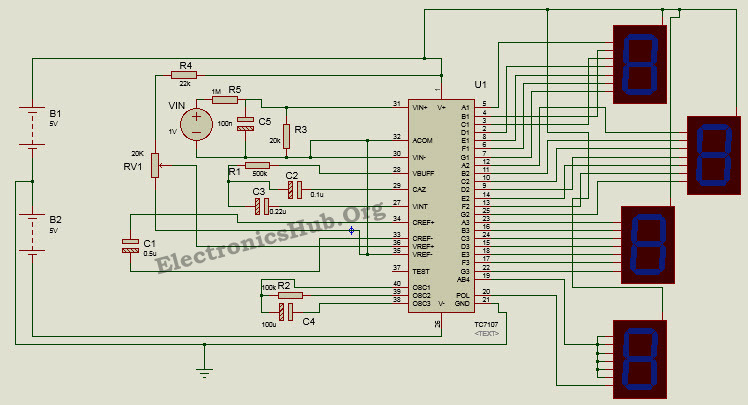Digital
voltmeters are often preferred these days over analog voltmeters owing
to their accuracy and high rate of precision. Also digital systems are
preferred because of their less exposure to noise and good data
compression capability. A voltmeter is an instrument measuring the
potential difference between two points. A typical digital voltmeter
consists of a analog to digital converter and a digital display.
Analog to
digital conversion involves transforming a signal from its continuous
form to discrete form using electronic integrated circuitry. An analog
to digital converter can be a dual slope converter, successive
approximation converter, flash converter or a delta sigma converter.
Here we
design a analog to digital converter working as a digital voltmeter
using a low power three and half digit A/D converter ICL7107 having
internal 7 segment decoders, display drivers, a reference and a clock.
An advantage is this IC can directly drive non multiplexed seven segment
display without any external decoding circuitry. The circuit can
measure voltage in the range of 200mV to 2V with an interval of 0.001V.
Principle Behind the Circuit:
This
circuit is based on the principle of using ICL7107 as an analog to
digital converter. The whole operation is divided into two phases-
Analog to digital conversion and decoding. Analog to digital conversion
is done using the process of integrating and reference integrating. In
other words, the input signal is first integrated to bring the output of
integrator to ramp signal and an opposite polarity reference voltage is
then integrated to bring the output of integrator back to zero. The
resultant digital code obtained is then decoded using to display
decoders to drive the display unit.
Do you know the working of Digital Voltmeter Circuit using 8051 Microcontroller?
Digital Voltmeter Circuit Diagram using ICL7107:

Circuit Diagram of Digital Voltmeter using ICL7107
How Design Digital Voltmeter Circuit?
Designing the circuit requires appropriate selection of the components as given below:
- Selection of Oscillation Circuit Components: For a typical oscillating frequency of 48 KHz, the oscillating resistor has been chosen to be about 100K and the capacitor about 100pF.
- Reference Capacitor: The value of reference capacitor is chosen to be between 0.1uF and 1uF. Here we choose a 0.5uF electrolyte capacitor.
- Auto-zero Capacitor: The auto zero capacitor is selected such that its value is between 0.01uF and 1uF. Here we select a 0.1uF capacitor.
- Integrating Capacitor: The integrating capacitor forms an essential part of the integrating circuit. Its value is determined by the integration period t, optimum integration current I and integrated voltage Vint. For a time period of 83mSec, current of 4uA and voltage of 2V, the value of capacitor is found to be around 0.16uF. Here select a 0.22uF capacitor.
- Integrating Resistor: The value of this resistor is given by the full scale analog input voltage and the optimum integration current. We select a resistor of 500K for a full scale input voltage of 2V.
How to Operate Digital Voltmeter Circuit?
The IC is
powered by a dual supply of +/- 5V. Once the circuit is powered, the
reference signal is set by adjusting the reference resistor. The
reference voltage needs to be about half of the input voltage. The
oscillating components – resistor and capacitor determine the
oscillating or clock frequency of the device. The reference capacitor is
charged to the reference voltage. A feedback loop is then closed to
charge the auto zero capacitor such that is compensates for any
fluctuations in voltages. Later the converter integrates the
differential voltage at the input for a fixed time such that output of
the integrator is a ramp signal. A known reference voltage is then
applied to the input of integrator and is allowed to ramp till the
output of integrator becomes zero. The time taken for the output to
return back to zero is proportional to the input signal and the digital
reading is given as:
Display Count = (Vin/Vref)*1000.
The next
process involves decoding the digital count to produce a seven segment
compatible signal so as to drive the displays. The digital output is
then displayed on the multiplexed 7-segment display.
Applications of Digital Voltmeter Circuit:
- This circuit can be used in digital multimeters to provide digital reading of measured voltage.
- It can be used to measure AC and DC voltages.
- It can be used to measure physical quantities like pressure, temperature, stress using transducer circuit and signal conditioning circuit.
- It can be used in applications where high accuracy and high resolution is required.
Limitations of Digital Voltmeter Circuit:
- It can measure voltages only up to a low range.
- The IC used is a CMOS device and is highly static.
- Difference in reference voltage for negative and positive input voltage can cause rollover error, i.e. a common mode error.
- Using a full scale negative input voltage of 2V can sometimes cause output of the integrator to saturate.
- Internal heating from the LED drivers can cause degradation in performance.
- Reference temperature coefficient, internal chip dissipation and package thermal resistance tend to increase the noise level.
No comments:
Post a Comment